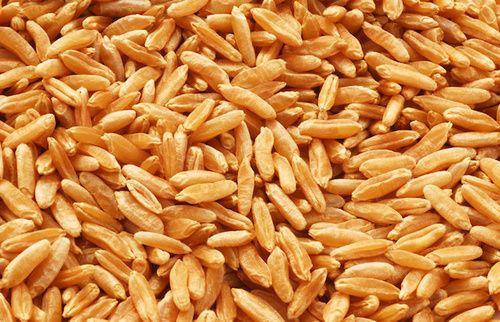Kamut flour it is obtained by grinding the wheat Triticum turgidum turanicum, or an oriental wheat. R.icca of selenium, zinc, magnesium and vitamin E, kamut flour is also perfect for athletes. Let's find out better.
> 2. Properties and use of kamut flour
> 3. Products based on kamut flour

How kamut flour is made
Kamut flour is the product of the grinding of Triticum turgidum turanicum wheat, that is an oriental wheat (Egypt, ancient Mesopotamia) belonging to the Graminaceae family, also known as red wheat or khorasan.
During the XNUMXs, an American agronomist and biochemist, Bob Quinn, became interested in this type of grain with a particularly long kernel and called it kamut.
The name derives from ka'moet which, in the Egyptian language means "soul of the earth". The Quinn family, around the 90s, began to market wheat and derivatives under this name. Only through the use of a registered trademark is it guaranteed to consumers that khorasan kamut wheat products contain the pure and ancient variety of khorasan wheat, with high quality standards, grown according to the organic farming method.
Basically, khorasan wheat can be grown freely, but it cannot be called kamut as this name can only be used by the American company.
Properties and use of kamut flour
Kamut flour is made from wheat that contains a decent amount of protein and it is remarkably pure from contamination with modern wheat varieties.
It is a very resistant product, which grows well without pesticides and chemical contamination, rich in selenium, zinc, magnesium and vitamin E.
Containing a high percentage of lipids, kamut flour is very energetic, suitable for the elderly, children or athletes. It is not suitable for celiac disease sufferers as it contains gluten.
Kamut flour products
Kamut flour lends itself to the preparation of many recipes. There are also many products based on kamut flour: from breadsticks, savory biscuits, to breakfast cereals, kamut bread, pizzas, focaccia, quiches and biscuits.
With this flour you can also make crepes, pasta and flours for food use. kamut grain is used as ingredient for soups, broths or salads.
The quality of gluten contained allows you to work the flour for the pasta without having to use eggs. It is easily found in specialized organic shops, supermarkets, as well as on the Internet.
A recipe up your sleeve
Kamut flour pizza - basic dough
Ingredients:
- 500 grams of kamut flour,
- three tablespoons of extra virgin olive oil,
- salt 10 grams,
- a cube of brewer's yeast,
- a teaspoon of honey,
- water.
Method: Take a bowl, pour a glass of warm water, crumble the brewer's yeast with the honey into it. Mix until everything melts well and put the mixture of water and yeast in the center of the flour. Separately, dissolve 10 grams of salt in another glass of warm water and add the oil, putting everything in the flour. Knead until reaching the exact, soft and elastic consistency.
Properties, calories and nutritional values of kamut
Other articles on the kamut:
> Kamut and gluten: let's be clear
> Kamut pasta, an alternative for celiacs?
> Kamut pizza: the recipe
> The salad with wholemeal kamut: the recipes
> Kamut flour, 3 recipes
| Wikimedia


























